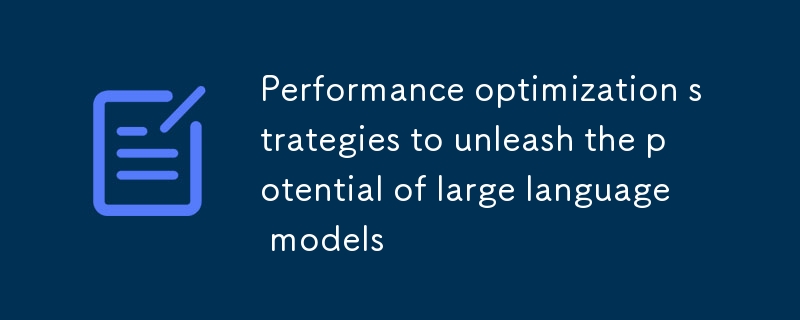Home >Technology peripherals >AI >Performance optimization strategies to unleash the potential of large language models
Performance optimization strategies to unleash the potential of large language models
- DDDOriginal
- 2024-08-13 15:25:19530browse
This article explores innovative methods for enhancing the computational efficiency of large language models (LLMs), including utilizing specialized hardware, implementing model and data parallelism, and leveraging mixed precision training. It also d

Question 1: What innovative methods can enhance the computational efficiency of large language models?
Answer: Innovative methods to enhance the computational efficiency of large language models include:
- Utilizing specialized hardware accelerators, such as GPUs or TPUs, to handle the intensive computations required by large language models.
- Implementing model parallelization techniques, which distribute the model across multiple GPUs or TPUs, allowing for simultaneous processing and reducing training time.
- Employing data parallelism, where different batches of data are processed concurrently on separate devices, further accelerating training.
- Leveraging mixed precision training, which utilizes a combination of data types (e.g., float16 and float32) to reduce memory consumption and improve training stability.
Question 2: How do different system architectures impact the scalability and performance of large language models?
Answer: The choice of system architecture significantly affects the scalability and performance of large language models:
- Centralized architectures consolidate all model components on a single server, providing high performance but limited scalability.
- Distributed architectures span multiple servers, enabling horizontal scaling and handling larger models and datasets. However, they introduce communication overhead and require careful resource management.
- Hybrid architectures combine elements of both centralized and distributed approaches, offering a balance between performance and scalability.
Question 3: What techniques are effective in optimizing memory consumption and reducing latency during the training and inference phases of large language models?
Answer: Techniques for optimizing memory consumption and reducing latency include:
- Gradient accumulation, which accumulates gradients over multiple batches before updating model parameters, reducing memory usage during training.
- Pruning techniques, which identify and remove redundant or less important connections in the model, resulting in a smaller and more efficient model.
- Quantization techniques, which convert model weights to lower-precision data types (e.g., from float32 to int8), reducing memory requirements and improving inference speed.
The above is the detailed content of Performance optimization strategies to unleash the potential of large language models. For more information, please follow other related articles on the PHP Chinese website!
Related articles
See more- Technology trends to watch in 2023
- How Artificial Intelligence is Bringing New Everyday Work to Data Center Teams
- Can artificial intelligence or automation solve the problem of low energy efficiency in buildings?
- OpenAI co-founder interviewed by Huang Renxun: GPT-4's reasoning capabilities have not yet reached expectations
- Microsoft's Bing surpasses Google in search traffic thanks to OpenAI technology

